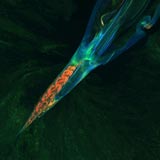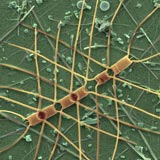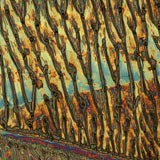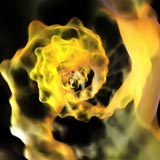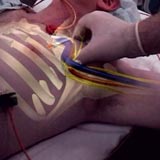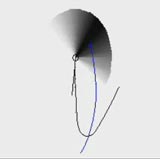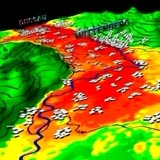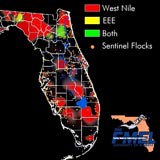
VISUALIZATION CHALLENGE
2004 Winners
Photography
Honorable Mention
Autofluorescence of Tick Nymph on a Mammalian Host
Marna E. Ericson, University of Minnesota
Laser scanning confocal microscopy captured the autofluorescence of a common deer tick as it feasted on the ear of a golden hamster.
Honorable Mention
Antarctic Diatom Chain
Dee Breger, Materials Science and Engineering Department, Drexel University
A microplankton sample pulled from the depths of the Antarctic Sea was captured by a scanning electron micrograph.
Honorable Mention
Pasture of Instabilities
Linda M. Strzegowski, Ting Xu, Materials Research Science and Engineering Center, University of Massachusetts
An electric field was applied to a thin film of polystyrene. The field amplifies irregularities on the surface of the film, which appear as colorful patterns under optical microscopy.
Illustration
First Place
Water Permeation Through Aquaporins
Emad Tajkhorshid, Klaus Schulten, Theoretical and Computational Biophysics Group, University of Illinois at Urbana-Champaign
This is a snapshot of an atomic simulation in progress. Boomerang-shaped water molecules slip as they march single file through the narrow pore of the gold aquaporin, while the red balls and fibers that make up the cell's membrane keep the outside water (top) from mixing with the cellular pool (bottom).
Honorable Mention
Spiral IV
Kenneth Eward, BioGrafx Scientific & Medical Images, Ovid, Michigan
X-ray crystallographic data was used from real DNA molecules to paint a unique portrait of the double helix. The image omits the chemical bonds that crisscross the center of the molecule, so that the structural features of the helix, such as the major and minor grooves, can be seen more easily.
Informational Graphics
First Place
Mt. Etna
David Fierstein, Felton, California
This graphic cuts to the core of one of the world's most unusual volcanoes in Mt. Etna. The image merges the latest scientific data with state-of-the-art 3D modeling software to give a comprehensive view of the volcano's rich and violent history.
Interactive Multimedia
Honorable Mention
Brachial Plexus
Paul Bigeleisen, Strong Memorial Hospital, Rochester, New York
Physicians may be able to improve their accuracy in giving shots using this interactive DVD. The presentation combines ultrasound, virtual reality, animation and see-through videography to provide a detailed roadmap of the peripheral nervous system in a living patient.
Honorable Mention
RNAi - A Ballet of Molecular Machines
Doug Huff, Beth Anderson, Simon Fenwick, N. Leigh Anderson, Norman G. Anderson, Arkitek Studios, Seattle, Washington
RNA interference is a complex set of cellular processes that converts a foreign piece of double-stranded RNA into a potent gene blocker. This is a narrated interactive video that takes viewers inside a living cell as double-stranded RNA is introduced.
Noninteractive Multimedia
First Place
Bat Intercepts Flying Insect
Cynthia F. Moss, Kaushik Ghose, University of Maryland, College Park
Under infrared light, a large winged object locks onto and overtakes a small blip, while a radar-like display tracks the entire proceeding. This is an experiment designed to understand how bats use sonar to capture their prey.
Honorable Mention
The Elbe River Flood 2002
Nils Sparwasser, Christian Gredel, Adelheid Craubner, Thomas Ruppert, Robert Meisner, German Aerospace Center, Oberpfaffenhofen
This 3-D presentation incorporates optical and radar data from 10 satellites to send viewers on a bird's-eye journey over Eastern Europe in August 2002 as entire cities are consumed by the worst flooding to hit the region in more than 100 years.
Honorable Mention
Spatiotemporal Arboviral Surveillance in Florida During 2003
Gregory Ross, Jonathan Day, Roxanne Rutledge-Connelly, Florida Medical Entomology Laboratory, Institute of Food and Agricultural Sciences, University of Florida
Clouds of red, yellow and green transiently materialize over various regions of the state of Florida as antibodies against the West Nile and Eastern Equine Encephalitis viruses appear in sentinel chicken flocks throughout the year.



